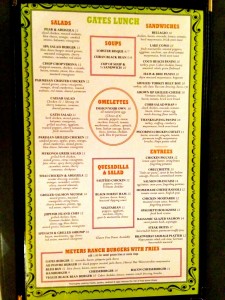 Not everyone reads the menu the same way. Actually, reading a menu can be a little like reading a newspaper. Think about it – where do your eyes go first? Researchers have studied what most of us do and savvy restaurateurs make good use of their findings when they design their menus.
Not everyone reads the menu the same way. Actually, reading a menu can be a little like reading a newspaper. Think about it – where do your eyes go first? Researchers have studied what most of us do and savvy restaurateurs make good use of their findings when they design their menus.
Where Do Restaurants Usually Feature Their Most Profitable Items?
Look at a menu. The most important ideas are at the top right of the front page — the spot where your eyes tend to land first. In a two-page/single-fold menu, the most common type, the top right is where you’ll most likely find the most profitable items or the specials. In a single-page format, where the entire menu is on a single page or card, the area of focus is the top half of the page.
Do You Read Or Scan?
Most people don’t “read” a menu but rather “scan” it with their eyes. It makes sense to put the items the restaurant wants to sell where your eye goes first. “Eye magnets” like colored boxes, large fonts, or icons and symbols help direct your gaze. Bold typefaces grab attention and are designed to steer you to what they want you to order. Well thought out use of eye magnets can increase restaurant sales up to 10%.
Where Do You Look First?
On a two-page menu, a lot of us often go to the right page, go back and read the left page, and then back to the top right to take another look. By the time most of us get to the middle and bottom of the right page our attention is fading. That ends up being where restaurants put items they don’t mark up or ones they know will sell anyway. For instance, unless you’re in a steakhouse, that’s where you’ll probably find the steak — because those of us who are going to order steak are usually going to order it regardless of where it is on the menu. Items they don’t want to feature — maybe things that don’t make money or stand-bys like burgers or eggs that sell anyway — go below the high profit items or on the back of a three or four page menu.
Tip: You’ll likely find a restaurant’s most profitable items or specials — the things they want you to order — on the top right of the front page of a two-page menu or the top half of the page on a single page menu.
Eye Magnets
Some newer research has shown that some of us may read the menu sequentially – the reason menus start with appetizers, go to entrees, and end with dessert, with soup and salad in between.
Regardless of your menu reading habits – some people scan the dessert choices first to figure out if they’ll start with a “lighter” appetizer and go for a big time dessert – the purpose of “eye magnets” and other attention getting mechanisms is to direct your eye toward what the restaurant is highlighting (some might call it “pushing”).
Tip: “Eye magnets” — like colored boxes, larger fonts, and icons or symbols — are used to help direct your gaze.
Do you eat out? This is the fourth article in a series of consecutive posts about decoding restaurant menus. Keep checking back for more information that might help you with your restaurant choices.
Please share if you know anyone who wants to eat out and eat well!

Leave a Reply